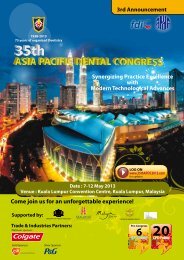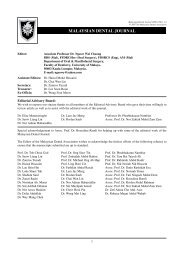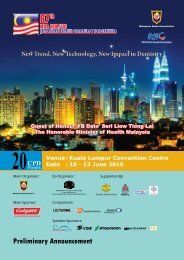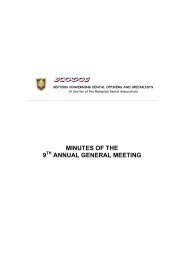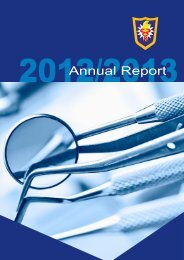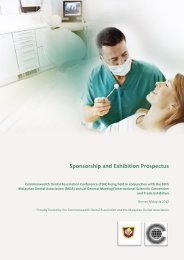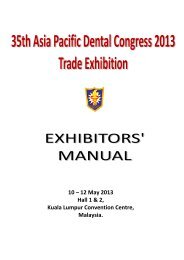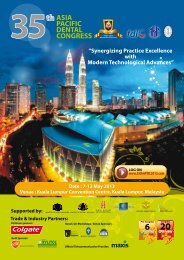MALAYSIAN DENTAL JOURNAL<strong>Malaysian</strong> <strong>Dental</strong> Journal (2008) 29(2) 84-93© 2008 The <strong>Malaysian</strong> <strong>Dental</strong> <strong>Association</strong>Are Cox-2 Inhibitors A Solution To Problems Associated With Current OralAnalgesics? A Revisit With A Perspective Of Local Need.WC Ngeow. BDS (Mal), FFDRCSI (OS), FDSRCS (Eng), MDSc (Mal)ST Ong. BDS (Mal), FDSRCPS (Glasg)Department of Oral & Maxillofacial Surgery, Faculty of Dentistry, University of Malaya, 50603 Kuala Lumpur,Malaysia.ABSTRACTThe primary obligation and ultimate responsibility of a dental surgeon is not only to restore aesthetic and function,but also to relieve pain which originates from dental pathology or surgical procedures performed. Post operativedental pain is mainly of inflammatory origin. Common traditional oral analgesics, namely salicylates, paracetamoland non-steroidal anti-inflammatory drugs have been the drugs of choice, but are increasingly being supersededby newer designer analgesics, the cyclooxygenase-2 (COX-2) inhibitors. This article reviews the advantages anddisadvantages of prescribing common traditional oral analgesics as well as exploring the potential use of COX-2inhibitors as an alternative to these analgesics for the control of post operative pain in dentistry.Key wordspain, analgesic, NSAIDs, COX-2 inhibitorIntroductionPain can originate from dental pathology or asan outcome of trauma or surgical procedures performedon patients. Postoperative dental pain is mainly ofinflammatory origin and is caused mainly by increasedprostaglandin (PG) synthesis. 1,2 Pain studies showed thatmajority of patients suffered their highest pain level on theday of operation, especially within the first 3 to 5 hourspostoperation. 3,4 This happens irrespective of their age,operating time, who the operators are, types of impactionand presence or absence of pericoronitis during theprevious 3 weeks. 3 It was suggested that pain was however,influenced by the gender of the patients. 3,5Analgesics most commonly prescribed in dentistryfor acute minor oral surgical pain relief include salicylates,the nonsteroidal anti-inflammatory drugs (NSAIDs),paracetamol and various opioid-containing analgesiccombinations. As these oral analgesics have been usedfor a long time and have well proven track records, theauthors wish to group them as “common traditionaloral analgesics”. Paracetamol and the NSAIDs such asmefenamic acid and ibuprofen, are examples of analgesicscommonly prescribed for minor oral surgical procedures inMalaysia . 6 These NSAIDs (salicylates included) andpresumably paracetamol act by inhibiting enzymecyclooxygenase responsible for the formation of PGs thatpromote pain and inflammation. 7Although NSAIDs are effective analgesics for mild tomoderate pain, they are associated with potentially seriousside effects, including gastrointestinal (GI) haemorrhageand ulceration and alteration of platelet function. 8 Thesehappen because NSAIDs inhibit both the constitutive (COX-1) and inducible (COX-2) isoforms of cyclooxygenase(COX).The induction of COX-2 after inflammatory stimulihas led to the hypothesis that COX-2 inhibition primarilyaccounts for the therapeutic properties of NSAIDs. COX-2inhibitors now constitute a new group of NSAIDs which, atrecommended doses, block the production of PG by COX-2, but not COX-1. Two COX-2 inhibitors are currentlyavailable in Malaysia – celecoxib (Celebrex®, Pfizer),which is taken twice daily, and etoricoxib (Arcoxia®,MSD Merck), which is taken once daily. Celecoxiband etoricoxib show significantly lower incidences ofgastrotoxicity than non-selective NSAIDs but at the sametime show potent analgesic property. 9,10-13 Moreover, incomparison with conventional NSAIDs, celecoxib andetoricoxib generally have a longer duration of action; 12hours and 22 hours respectively.This article reviews the advantages and disadvantagesof prescribing common traditional oral analgesics as wellas exploring the potential use of COX-2 inhibitors asan alternative to these analgesics for the control of postoperative pain in dentistry.84
Ngeow / OngRole of NSAIDs in post operative dental painNon-steroidal anti-inflammatory drugs (NSAIDs)are the most commonly prescribed analgesic agents fororal surgical outpatients. It has been more than 30 yearssince Sir John Vane first reported that the pharmacologicalactions of aspirin-like drugs could be explained by theirability to inhibit enzyme cyclooxygenase (COX). 14In specific, aspirin and related NSAIDs work atthe site of tissue damage, the spinal cord and/or higherbrain centres to prevent PG formation by inhibitingcyclooxygenase, or COX activity. 7 In 1990, the enzymeCOX was demonstrated to exist in 2 distinct isoforms,constitutive (COX-1) and inducible (COX-2) isoforms. 15With partial exception of paracetamol, which has minimalanti-inflammatory effects, NSAIDs exert a combination ofanalgesic, anti-pyretic, and anti-inflammatory effects bytheir actions on both COX-1 and COX-2. 7Nearly all NSAIDs marketed today inhibit bothCOX-1 and COX-2, and most have selectivity for COX-1. 16 However, not all NSAIDs are equal. Some arebetter analgesics, while others are more effective antiinflammatories.They also vary greatly in the degree ofside effects produced. 17,18 Because of the clear differenceswith respect to the relative inhibition of these enzymesby different NSAIDs, the Relative IC50 (concentrationrequired to produce 50% inhibition of COX activity)values for COX-1 and COX-2 are calculated. This COX-2/COX-1 ratio indicates the relative inhibition of theseenzymes. A high ratio is most desirable because it impliesthat the compound is a relatively specific COX-2 inhibitor.Epidemiologic studies demonstrate that this ratio correlatesclosely with the safety profile of NSAIDs. 16 The COX-2/COX-1 selectivity ratios of some commonly used traditionalNSAIDs are shown in Table 1. 18,19 The reasons for differentCOX specificities are not entirely clear but one theory isthat nuclear COX-2 may be more susceptible to drugs thatcan cross plasma membranes and endoplasmic reticulumefficiently.Table 1: COX-2/COX-1 ratios of traditional NSAIDsNSAIDsMeloxicam 4.00Aspirin 3.12Ibuprofen 1.78Indomethacin 1.78Naproxen 0.88Ketorolac 0.68COX-2/COX-1 ratio** A ratio of >1 indicates a greater inhibition of COX-2than COX-1As the prototypical NSAID, aspirin remains thegold standard against which other orally active analgesicsare compared. It is relatively selective for COX-1 and ittherefore has a tendency to cause gastric bleeding andulceration, especially when used in high doses and fora long duration of time. Aspirin works by acetylatingthe enzyme COX. Typical doses of 325mg and 650mgencompass most of aspirin’s analgesic dose response curvein the average adult. 7Ibuprofen was the first NSAID that demonstrateanalgesic superiority to aspirin. 7 A 400 mg dose ofibuprofen has been shown to have a greater peak analgesiceffect and a longer duration than 600 mg of aspirin or 1 gmparacetamol, or 60 mg of codeine. It has at least comparableefficacy to traditional opioid analgesic combinations. 20,21However, the half-life of ibuprofen is short, at only twohours.Naproxen sodium, an NSAID structurally relatedto ibuprofen, has a half-life of about 13 hours. This allowsfor less frequent dosing as compared to ibuprofen. A 220mg dose of naproxen sodium is equivalent to 200 mgof ibuprofen in analgesic onset and peak effect but hasa longer duration of action. 22 The same holds true if thedosage is doubled for both analgesics. 23Diclofenac, ketoprofen, flurbiprofen,meclofenamate, and diflunisal are additional NSAIDs withanalgesic activity in the dental setting similar to that ofibuprofen or naproxen. Fenoprofen is also approved for themanagement of acute pain, but its slow absorption retardsthe onset of analgesia. Ketorolac, an NSAID commonlyused for parenteral administration, is resticted in its oraldosage form to patients who have already received thedrug by injection. Lastly, etodolac is a well-toleratedNSAID but has not been proven to be superior to aspirinfor relieving pain of dental origin. 7The major limitations of NSAIDs are theirgastrointestinal (GI) adverse effects (perforation, ulcerationand bleeding), impairment of haemostatic function, andrenal failure (with long-term therapy). It has been reportedthat 15 to 20% of patients taking NSAIDs developpeptic ulcer and almost 3% of this group experiencegastrointestinal haemorrhage or ulcer perforation at somepoint of time. 24,25 In addition, they are not recommendedduring pregnancy and lactation. 26Mefenamic acid, the most popular oral analgesics fordental pain in MalaysiaMefenamic acid is a member of the fenamategroup of NSAIDs first discovered in 1962. In one of thefirst clinical trials conducted, Cass and Frederik 27 foundthat 250mg of mefenamic acid was superior to 600 mg ofaspirin and approximately equivalent to 50 rag of codeine(base) or a combination of 227.5 mg of aspirin, 162.5 mgof acetophenetidin, 32.5 rag of caffeine, and 25 mg ofcodeine (base). They also found a great increase in efficacywhen the dose was doubled, resulting in the currentrecommended dosage of 500 mg for moderate pain.Mefenamic acid is used for the relief of mild–to–moderate pain in doses up to 500 mg three times dailyfor the treatment of rheumatoid arthritis. It is also used torelieve pain arising from soft tissue injuries, dysmenorrhoea,menorrhagia and other painful musculoskeletalconditions. 28-30 In Malaysia, it is widely used for thecontrol of postextraction and postsurgical dental pain. 6 Itcan also be used as a rescue analgesic, as shown in a study85



